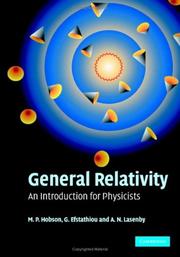| Listing 1 - 4 of 4 |
Sort by
|

ISBN: 9780521829519 0521829518 Year: 2012 Publisher: Cambridge: Cambridge university press,
Abstract | Keywords | Export | Availability | Bookmark
 Loading...
Loading...Choose an application
- Reference Manager
- EndNote
- RefWorks (Direct export to RefWorks)
After reviewing the basic concept of general relativity, this introduction discusses its mathematical background, including the necessary tools of tensor calculus and differential geometry. These tools are used to develop the topic of special relativity and to discuss electromagnetism in Minkowski spacetime. Gravitation as spacetime curvature is introduced and the field equations of general relativity derived. After applying the theory to a wide range of physical situations, the book concludes with a brief discussion of classical field theory and the derivation of general relativity from a variational principle.
Book
ISBN: 9780199662869 9780199662852 019966286X 0199662851 9780192856791 9780192893543 9780192895646 9780192856791 Year: 2012 Publisher: Oxford: Oxford university press,
Abstract | Keywords | Export | Availability | Bookmark
 Loading...
Loading...Choose an application
- Reference Manager
- EndNote
- RefWorks (Direct export to RefWorks)
The aim is to make manageable what would otherwise be regarded as hard; to make derivations as simple as possible and physical ideas as transparent as possible. Lorentz invariants and four-vectors are introduced early on, but tensor notation is postponed until needed. In addition to the more basic ideas such as Doppler effect and collisions, the text introduces more advanced material such as radiation from accelerating charges, Lagrangian methods, the stress-energy tensor, and introductory General Relativity, including Gaussian curvature, the Schwarzschild solution, gravitational lensing, and black holes. A second volume will extend the treatment of General Relativity somewhat more thoroughly, and also introduce Cosmology, spinors, and some field theory. Relativity Made Relatively Easy presents an extensive study of special relativity and a gentle (but exact) introduction to general relativity for undergraduate students of physics. Assuming almost no prior knowledge, it allows the student to handle all the Relativity needed for a university course, with explanations as simple, thorough, and engaging as possible.
Book
ISBN: 9782070443147 Year: 2012 Publisher: Paris : Gallimard,
Abstract | Keywords | Export | Availability | Bookmark
 Loading...
Loading...Choose an application
- Reference Manager
- EndNote
- RefWorks (Direct export to RefWorks)
A mind-bending book about modern physics, quantum mechanics, the fate of stars and the deep mysteries of black holes. What happens when something is sucked into a black hole? Does it disappear? Three decades ago, a young physicist named Stephen Hawking claimed it did--and in doing so put at risk everything we know about physics and the fundamental laws of the universe. Most scientists didn?t recognize the import of Hawking?s claims, but Leonard Susskind and Gerard t?Hooft realized the threat, and responded with a counterattack that changed the course of physics. This is the story of their united effort to reconcile Hawking?s revolutionary theories with their own sense of reality--effort that would eventually result in Hawking admitting he was wrong, paying up, and Susskind and t?Hooft realizing that our world is a hologram projected from the outer boundaries of space.--From publisher description.
Quantum theory. --- General relativity (Physics) --- Black holes (Astronomy) --- Space and time. --- Théorie quantique --- Relativité générale (Physique) --- Trous noirs (Astronomie) --- Espace et temps --- Hawking, Stephen,
Book
ISBN: 9780821853580 Year: 2012 Volume: no. 1025 Publisher: Providence, R.I. Americqn Mathematical Society
Abstract | Keywords | Export | Availability | Bookmark
 Loading...
Loading...Choose an application
- Reference Manager
- EndNote
- RefWorks (Direct export to RefWorks)
Quantum mechanics. Quantumfield theory --- Differential equations --- Mathematical physics --- Einstein field equations. --- Shock waves --- Relativistic quantum theory. --- General relativity (Physics) --- Equations du champ d'Einstein --- Ondes de choc --- Théorie quantique relativiste --- Relativité générale (Physique) --- Mathematical models --- Modèles mathématiques --- Mathematical models. --- 51 <082.1> --- Mathematics--Series --- Shock waves. --- Théorie quantique relativiste --- Relativité générale (Physique) --- Modèles mathématiques --- Einstein field equations --- Relativistic quantum theory --- Shock (Mechanics) --- Waves --- Relativistic quantum mechanics --- Quantum theory --- Special relativity (Physics) --- Relativistic theory of gravitation --- Relativity theory, General --- Gravitation --- Physics --- Relativity (Physics) --- Einstein's field equations --- Einstein's gravitational field equations --- Einstein's law of gravitation --- Field equations, Einstein --- Field theory (Physics) --- Gravitational fields
| Listing 1 - 4 of 4 |
Sort by
|

 Search
Search Feedback
Feedback About UniCat
About UniCat  Help
Help News
News